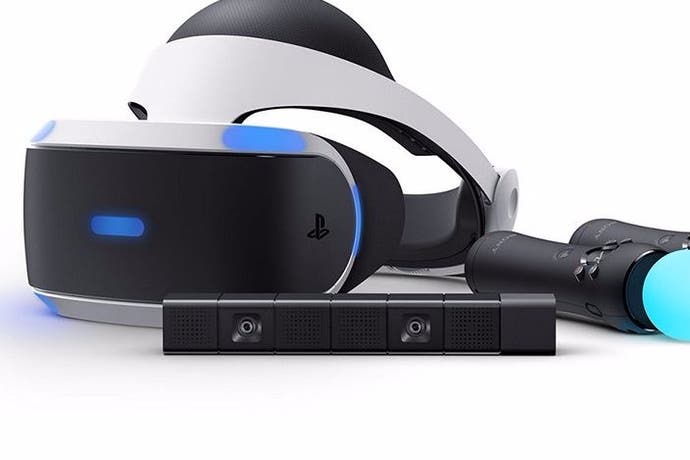What works and what doesn't in PlayStation VR's launch line-up
VR the champions my friend.
Sony's certainly putting its back into the launch of PlayStation VR - this is new hardware backed up with a software line-up that would make a new console proud. The new medium might still be looking for its killer app, but there's enough of interest in the initial batch to make it worthwhile. There are some curios, some duds as well as a genuine masterpiece that finds itself right at home on the new medium, and over the next few days we'll be bringing you full reviews of some of the key titles for PlayStation VR's launch. For now, though, here's a rundown of what's notable, what's worth playing and what's worth steering clear of if you're picking up a new headset tomorrow.
VR Worlds

VR might not have found its Wii Sports just yet, but good gosh are there plenty of Sports Champions lining up. This compendium of smaller experiences is patchy, yet it's probably the best starting point for many VR virgins. The shock and awe of a deep-sea dive cut rudely short by a great white shark is the kind of thing that can help sell the medium to newcomers, while the exquisitely produced (if achingly cheesy) cut-scenes of The London Heist book-end some exceptionally good use of PlayStation Move.
And, of course, there's the downside too, with VR Luge and Scavengers Odyssey showing virtual reality at its woozy worst. Given how all of its components lack any real replayability - and are often extended cutscenes - the price point seems too steep to comfortably recommend this one, especially seeing as Oculus Dreamdeck does much the same job on the Rift for free. MR
Tumble VR
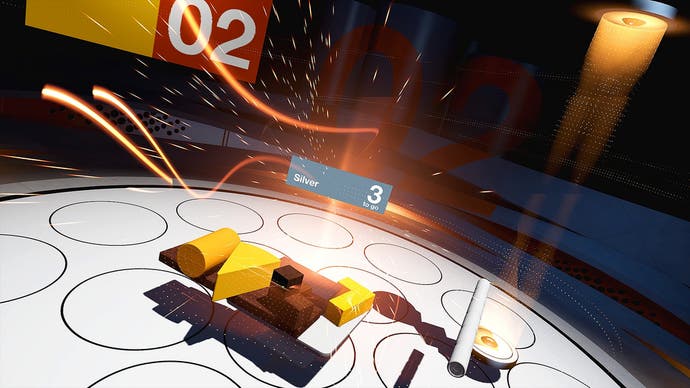
A perfect introduction to the strange tactile world of VR, Tumble also leaves Playstation's hardware with nowhere to hide. Either you can use the headset and the Move controllers to manipulate a range of chunky blocks and stack them in order to work through simple challenges, or you can't, and the whole thing is a bust.
Luckily, you can, and Tumble suggests that PSVR is both accurate and user-friendly. Block selection and manipulation using the controller quickly becomes second-nature, while the headset allows you to gauge distances and placement extremely well in this simple 3D environment. Best of all, Tumble VR is simply a good game, tasking you with stacking different shapes to reach a certain height one minute, while introducing a limbo bar to build under the next. Tying it all together is the arch, quietly brutal Portal-style narration that has quickly become de rigueur for puzzle games, and is not as annoying as you might expect it to be here. Tumble? You definitely will. CD
Rez Infinite

Tetsuya Mizuguchi's new studio makes its debut with Rez Infinite, itself a revisitation of one of the ex-Sega developer's best known games. It's as close to a banker as you can get when it comes to PlayStation VR launch games. Rez's laser-cool appeal hasn't dimmed a watt in the 15 years (!) since it first came out on Sega's Dreamcast, and Infinite's more than a mere remaster. In many ways, it's a realisation of everything the original wanted to be.
Here's a game that, it now seems so wonderfully clear, has always been aching for the VR revolution to arrive - immerse yourself in its ink-black soundscapes and there's a sense of Mizuguchi's original vision being set free. Take to Area X - an all-new area that takes Rez off its rails - and that feeling is made explicit as you float free through the abstract universe. VR's first masterpiece? Quite possibly so. MR
Until Dawn: Rush of Blood
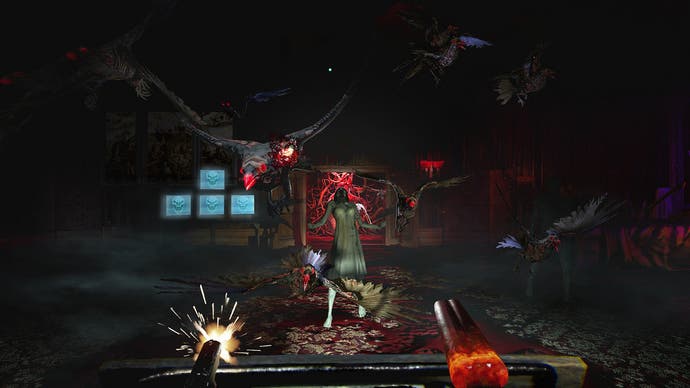
It is a bold on-rails shooter that lets you actually see the rails. In Rush of Blood they're a key component, however, as you take a ride on a spooky funfair ghost train to see your starting popguns replaced with weighty pistols, while the bobbing ducks and jack o'lanterns are traded for terrifying clowns that run at you with cleavers, before you blast meaty chunks out of their arms and legs.
Is this sophisticated stuff? Not remotely, but it is atmospheric and nicely staged, and with controls that cover both DualShock 4 and Move options, it works pretty well too. There's a combo system to get to grips with if you're after a little more elegance to your blasting, and things get increasingly clever in terms of the tricks that get played on you as you rattle along. Beyond that, it's nice to see a bit of honesty. There is a fairground novelty to VR, and Rush of Blood is quite at home with its own gimmicky nature. CD
RIGS

A stylish and nippy mech-based arena blaster, people have spent a lot of money on RIGS. Sadly, based on an hour or so with it this morning, it's going to make a lot of other people very sick. Nausea's a problem with a lot of VR games, but RIGS was always going to be prone to it, I suspect, because it requires such fast turns and sudden movements. It heads right to the inmost cave of things that make you want to puke in VR.
It's a shame, too, because there's something quite special here, by the looks of it, from the sleek mechs on offer to the curving arenas filled with neat hiding spaces. RIGS promises pacy action wrapped up in nice design work. Maybe, over time, you'll be able to get your stomach to play along. CD
Super Stardust Ultra VR
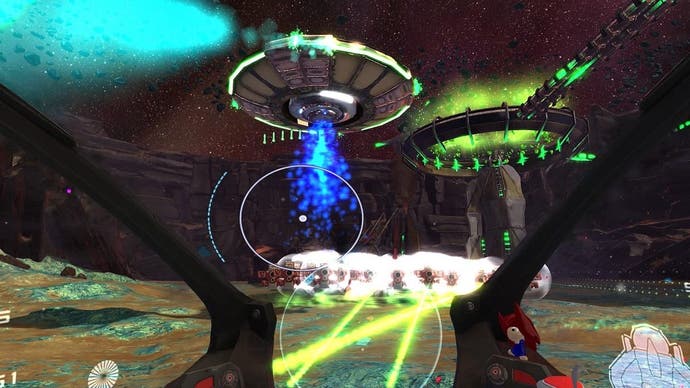
Even without the new VR mode, Super Stardust looks great in virtual reality, this pocket universe of spaceships, spacerocks, and alien invaders rendered wonderfully grabbable floating in three dimensions. You can play the entire traditional version of the game with the headset on, and then there's that special extra: a sort of wave-based arena thing in which you scud around in a craft in the first-person, blasting everything that comes your way.
It's nice enough, and it handles extremely well, and over a half hour or so, it didn't make me particularly nauseous. It's not the most imaginative use of VR out there, perhaps, but it's a welcome addition to a game that you may well already love. What's properly interesting, though, is the matter of what the original Super Stardust team would do with VR if they were starting from scratch. CD
Thumper
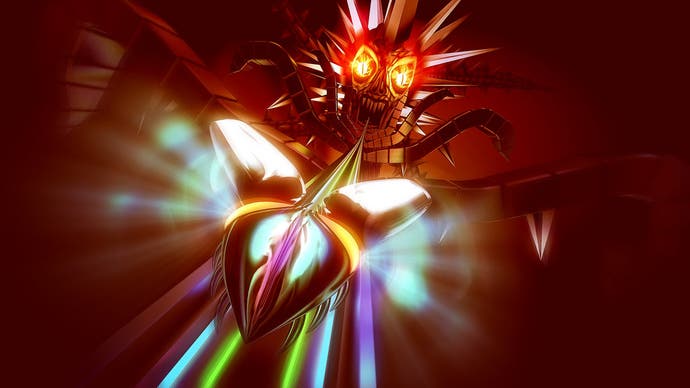
I've read Thumper described as a rhythm violence game, which is an odd but perfect summation. This is Temple Run for aesthetes, essentially: you move down a linear track pressing buttons in time to the beat to turn corners, smash through barriers, and bat explosive bursts of light back at bosses to defeat them.
That's the start, anyway, but it doesn't get at the strange core of the experience. Thumper is intoxicating, from the rhythmic, jouncing audio, to the movements of the sheeny metallic beetle you race along a channel that appears to have been made of hard light. Everything's slick and glossy and alien, and bosses spew Cthulian tentacles and hover, glowing in the distance. Is it a great use of VR? I suspect it would intoxicate just as strongly on pulsing away on the screen of a TV. With VR, though, you get the darkness, the privacy of the headset. Either way, this is not a game you should miss out on. CD
Batman: Arkham VR

This is a proper curio: a big budget studio bringing its talent and energy to an hour-long game: a strange adventure-game-style outing in which Batman knocks around Gotham City investigating a most personal kind of crime.
It's beautiful stuff: the city has never looked better than it does here, where you're plonked in the streets, looking up at the towers, or down in the Batcave messing around with gadgets and getting Bat-dressed. Interaction is nice, too, as you get a limited range of gadgets to bring to bear on a variety of simple puzzles. It's short, and it's light on action, but it feels generously stuffed with things for superfans to mess around with. It's Batman, but not as we've seen him before. If VR leads to more of these experiments, that can't be too bad, can it? CD
Battlezone VR

Rebellion's latest doesn't just take the legendary tank-based arcade game into the realms of VR. It also turns it into a Roguelike, of sorts, with campaigns procedurally generated as you move across a map of hexes and close in on a final objective. Each tile you land on whisks you away to a little arena where you blast around in your tank tackling a range of mission types, and there are Supply Point tiles to head towards, too, which allow you to swap weapons in and out of your load-out and buy new ones.
The structure's nice, but this is all about what happens on the playing field, and Battlezone, as is often the case with Rebellion, is clearly cut-price but also enormously charming. The flat colour low-poly graphics do a lovely job of updating the original game's Vector aesthetic, and your tank moves nimbly and allows you to exchange shields for boost. Enemy AI is basic, but as missions are short and there's a surprising amount of space to play with, it's hard to get too annoyed about it. Four-player co-op sweetens things further. CD
DriveClub VR

Driving games have already proved themselves well-suited to VR - there's something about the static cockpit and, if you're nerdy or flush enough, having a steering wheel that helps sidestep some of the fledgling medium's problems - so it's great to see PlayStation VR's launch accompanied by what's over time become something of a modern classic. DriveClub VR cannily transposes Evolution Studio's accomplished arcade racer into virtual reality - though there is, of course, a catch.
This is a standalone VR game, ensuring that any progress made in the vanilla version of the game is lost, rubbing a little extra salt into the wound that's opened when you're asked to buy the game all over again. There are some extra tracks not seen in the main game - a handful of urban jaunts around each of the locations - and the VR is implemented well enough, even if DriveClub's stellar visuals take a noticeable hit. It's not quite enough, though, to justify a full price-tag for what remains a fundamentally watered down version of the main game. MR
Eve Valkyrie
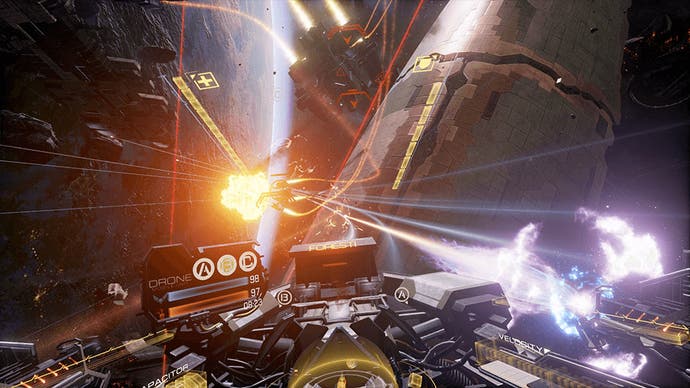
A posterchild for Oculus Rift upon its launch, Eve Valkyrie takes up much the same position at the dawn of PlayStation VR and still some six months on it remains one of the new medium's most complete games, and one of its most spectacular. That moment you first find yourself in the cockpit of a dog-fighter deep within the bowels of a space station, the dials lighting up as you rocket out into the floaty embrace of the heavens, still feels absolutely sublime, the targeting system that utilises head-tracking still a neat and efficient way to frag your foes.
Once that sense of wonder has died down a little, however, Eve Valkyrie remains something of a hollow game, and its emphasis on multiplayer won't be to everybody's tastes. Still, with the PC crowd getting involved thanks to cross-platform play, you'll hardly be short of others to play against. MR
Here They Lie

An abandoned subway, a mysterious woman in a yellow dress and so, so many questions. Here They Lie's a purposefully enigmatic exploration game tinged with horror - strange men in masks appear in shadows, while disconnected telephones soundtrack your adventures - that's been brought to life by new developer Tangentlemen with some help from Santa Monica Studios.
Unfortunately, the most terrifying thing about Here They Lie is the sickness it induces, an over-reliance on traditional first-person controls making this one of the more uncomfortable games to play on PlayStation VR at launch. Perhaps it's the diseased city you're walking through or maybe it's the murky textures of the world around you, but this one's guaranteed to make you queasy. More's the pity - there's an interesting game to be found here, though not via the medium of a PlayStation VR headset. MR
Headmaster

Headmaster is, to my knowledge, the only console game which has to issue a warning about whiplash, reminding you every few moments in the early game to adopt the correct position, lest you invite crippling spinal injury. Luckily, it's a largely spurious piece of health and safety, which nonetheless sits slightly at odds with the atmosphere of the game itself.
Headmaster is about headers. Good old forehead slapping headers like the ones you (I) fervently avoided at all costs at school because taking a 3lb piece of wet leather to the nose at speed seemed like it would be less satisfying than the risk/reward ratio would allow. Here, PSVR removes all need to find opportune moments to tie your bootlaces during a corner instead, sitting the player in a fixed position in front of a goal whilst a supply of virtual size-fives are delivered with perfect precision to your facial area. It's actually a lot of fun, with surprising nuance to the placement of the ball with subtle head movements. Whilst extended play does highlight the fact that you're swinging your head around whilst wearing a piece of solid consumer electronics on it, it's comfortable and physically undemanding. Fun, simple and completely intuitive, with a good sense of humour to boot. Or head. DP
Compiled by Christian Donlan, Martin Robinson and Dan Pearson.
